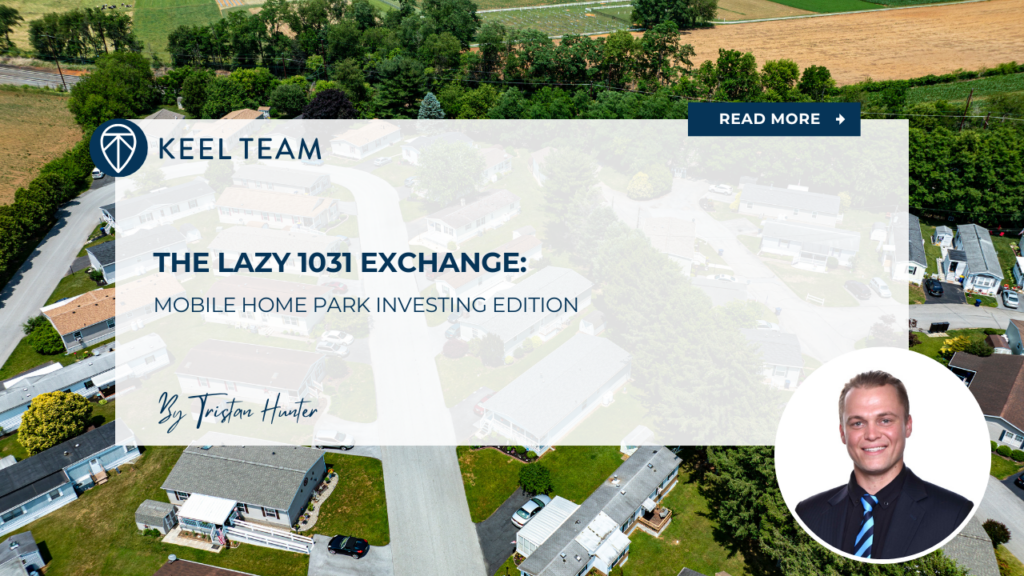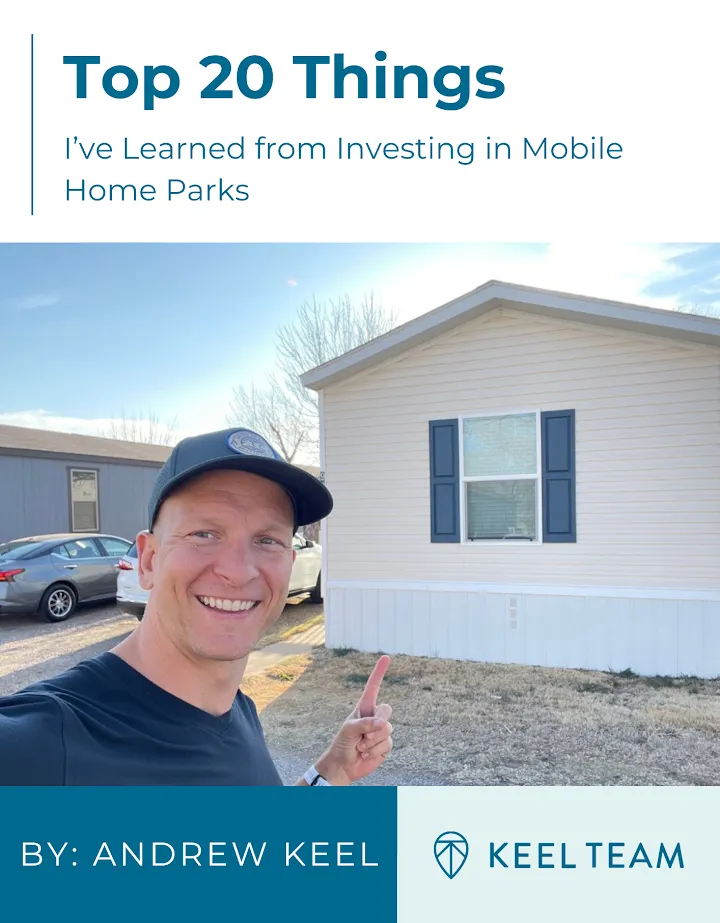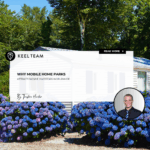The Lazy 1031 Exchange: Mobile Home Park Investing Edition
-
 Tristan Hunter - Investor Relations
Tristan Hunter - Investor Relations

In real estate investing, tax strategy often makes the difference between average and exceptional returns. One of the best-known strategies is the 1031 exchange — a method that typically allows investors to defer capital gains tax by rolling sale proceeds into another like-kind asset. But there’s an alternative approach gaining traction among savvy investors: the Lazy 1031 Exchange. While it’s not a formal IRS designation, this strategy can offer flexibility and powerful tax advantages, especially when applied to mobile home park investing.
Let’s break it down.
What Is a Lazy 1031 Exchange?
A “Lazy 1031 exchange” is a nickname for a strategy where real estate investors sell an investment property, realize the capital gain, then reinvest the proceeds into a passive investment — typically a real estate syndication — that offers accelerated depreciation.
Instead of deferring taxes via a traditional 1031 exchange, the investor uses the passive losses generated by depreciation from the new investment to offset the potential capital gains from the sale.
It’s not a literal exchange under IRS rules, but the end result can be similar: potential tax deferral through careful reinvestment.
How It Works in Practice
Here’s a simplified version of how the Lazy 1031 exchange might look in a mobile home park investing scenario:
- Sell an investment property and realize a taxable gain.
- Reinvest some or all of the proceeds into a passive deal (like a mobile home park syndication).
- Claim accelerated depreciation — often via cost segregation studies and bonus depreciation — from the new asset.
- Use those passive losses to offset any capital gains taxes from the sale.
This strategy depends on timing, structure, and passive income rules — so it’s critical to work closely with your CPA or tax advisor.
Download our FREE eBook on the Top 20 things to know BEFORE investing in mobile home parks!
Why Mobile Home Park Investments Fit the Strategy
Mobile home parks often work well for this approach for a few reasons:
- Depreciation potential is high. Mobile home park syndications often leverage cost segregation to accelerate depreciation early in the hold period.
- Many offerings are structured as passive investments. This allows investors to qualify for passive losses.
- Cash flow is often strong. Even as depreciation offsets gains, investors may still receive meaningful distributions.
- It’s scalable. Investors can allocate large amounts of capital into larger deals, often with professional operators.
In short, mobile home parks are one of the few asset classes that may offer both tax-efficient structures and strong upside potential.
Lazy 1031 vs. Traditional 1031 Exchange
Here’s how the two approaches compare:
| Feature | Traditional 1031 Exchange | Lazy 1031 Exchange |
|---|---|---|
| Capital gains tax deferred? | Yes | Potentially |
| Formal IRS compliance? | Required | Not needed |
| Timeline pressure (45/180 days)? | Yes | No |
| Reinvestment flexibility | Low (must be like-kind) | High |
| Use of depreciation to offset gains? | Not directly | Yes |
| Requires active involvement? | Often | No (passive) |
Both have their place. The Lazy 1031 approach simply gives investors another tool in the tax-planning toolbox, especially helpful when no ideal 1031 replacement is in sight.
Example Scenario
Let’s say an investor sells a self-managed duplex for a $300,000 gain. Rather than doing a traditional 1031 exchange, they reinvest the proceeds into a passive mobile home park syndication.
The syndication performs a cost segregation study and provides the investor with a $250,000 paper loss (via accelerated depreciation). That loss, under the right conditions, could be used to offset the capital gains from the sale of the duplex.
The investor still owes taxes on the remaining $50,000 of gain, but the bulk of the tax burden has been reduced or deferred, all while placing the capital into a passive, cash-flowing asset.

Key Considerations Before Using This Strategy
This strategy isn’t a shortcut — it’s a sophisticated approach that requires proper planning. Here are a few things to keep in mind:
1. You’ll Still Recognize the Gain
This isn’t a true 1031 exchange, so the IRS will see the sale as taxable. The offset happens via losses, not deferral.
2. You Need Passive Losses
Not all investments produce them. Mobile home park syndications often do — but verify this before investing.
3. Material Participation Rules Apply
If you’re classified as a real estate professional, the losses may be even more powerful. But for passive investors, losses can typically only offset passive income (or gains from the sale of passive investments).
4. It’s All Timing
You’ll want to ensure that the passive losses are available in the same tax year as your gain — timing matters here.
Why Some Investors Prefer This Strategy
While it might seem counterintuitive to not do a “proper” 1031 exchange, many experienced investors choose the Lazy 1031 route for a few simple reasons:
- It removes the 45-day and 180-day deadline pressures.
- It usually provides more flexibility in choosing higher-quality investments.
- It can reduce stress and risk in hot or overpriced markets.
- It simplifies paperwork and compliance.
And if you’re selling a property in a peak market cycle, there’s an argument that locking in your gain, then reinvesting it passively, may be just as powerful as deferring it altogether.
How the Keel Team Fits In
At Keel Team, we work with many investors who have recently sold real estate and are looking for a tax-efficient way to redeploy capital. For some, a traditional 1031 exchange into a mobile home park makes sense. For others, joining a mobile home park syndication and leveraging bonus depreciation to offset recent gains is a better fit.
We’re not tax advisors, but we’ve structured our offerings with these kinds of strategies in mind — offering both depreciation benefits and long-term upside potential through value-add execution.
Final Thoughts
The Lazy 1031 exchange is more than just a catchy nickname. It’s a real-world strategy that investors use to unlock potential tax benefits and reinvest capital without the constraints of a traditional 1031 timeline.
For mobile home park investing, it can be especially powerful, thanks to the combination of passive ownership, depreciation, and scalable growth potential. As always, it’s best to consult with your CPA or tax advisor before pursuing this strategy. Good luck!
Are you looking for MORE information? Book a 1-on-1 consultation with Andrew Keel to discuss:
- A mobile home park deal review
- Due diligence questions
- How to raise capital from investors
- Mistakes to avoid, and more!
Disclaimer:
The information provided is for informational purposes only and is not investment advice or a guarantee of any kind. We do not guarantee profitability. Make investment decisions based on your research and consult registered financial and legal professionals. We are not registered financial or legal professionals and do not provide personalized investment recommendations.

Tristan Hunter - Investor Relations
View The Previous or Next Post




